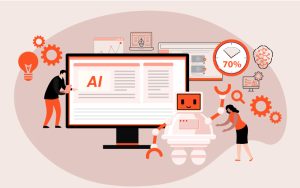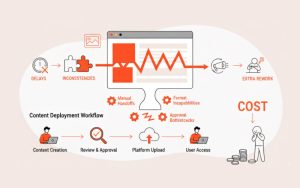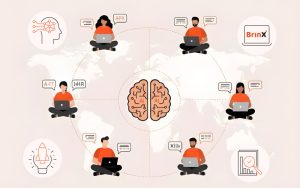Slide Decks Don’t Build Leaders. Experiences Do.
Most leadership programs still start with a slide. A slide about emotional intelligence. A slide about decision-making. A slide with someone else’s quote about listening.
But here’s the problem: leadership isn’t a spectator sport.
As work grows more complex, with remote teams, cross-functional decisions, and ethical ambiguity, leaders aren’t struggling to remember definitions. They’re struggling to act. This is the area in which the conventional leadership curriculum is inadequate.
High-achieving L&D teams are switching to scenario-based learning in 2025 from static presentations. And the shift is long overdue.
The Gap Between Leadership Theory and Practice
We know leadership development is critical. According to a 2024 Deloitte study, 81% of organizations cite leadership readiness as a top priority. Yet only 31% believe their current programs are effective.
Why the gap? Because most leadership programs still prioritize content delivery over behavior change. Learners watch. They click through. They move on.
But real leaders don’t just watch challenges, they live them.
Slide-based learning rarely creates tension or consequences. Yet in the real world, every leadership action has both. As a result, what’s taught in the virtual classroom often fails to transfer into the workplace.
What’s Not Working: Why Traditional Methods Fall Flat
Most leadership modules still rely on:
-
Narrated PowerPoints
-
Conceptual models (e.g., DISC, Situational Leadership)
-
One-size-fits-all scenarios
-
Multiple-choice knowledge checks
These tools aren’t bad. But they’re passive.
Take “feedback conversations.” You can read five models. You can watch a demo. However, you haven’t actually learnt anything unless you practice handling a genuine unpleasant discussion.
This discrepancy demonstrates a disregard for Kolb’s Experiential Learning Cycle, which calls on students to reflect, conceive, and experiment, as well as Merrill’s First Principles of Instruction, which place a strong emphasis on problem-centered learning.
Slides inform. Scenarios transform.
The Shift: Scenario-Based Leadership Development
What, therefore, constitutes an impactful curriculum?
Learning via scenarios is engaging, pertinent, and emotionally impactful. Theory is not the first step. It starts with a challenge.
For example:
You’re a new team lead. A high-performing team member is burning out. Morale is down. Deadlines loom. What do you do first?
From there, the learner chooses. Do they escalate to HR? Coach one-on-one? Reassign tasks? And most importantly, they see the impact of their decisions.
This approach maps to multiple proven models:
Kolb’s experiential learning theory: learning by doing and then reflecting on an experience
Self-Determination Theory: Students experience mastery, purpose, and autonomy.
Bloom’s Taxonomy (Apply, Analyze, Evaluate): Encourages more in-depth learning outcomes
Cognitive Load Theory: Information is automatically broken down into manageable chunks by scenarios
When implemented using agile models like SAM, L&D teams can test, iterate, and refine these experiences faster than traditional course builds.
How to Build a Scenario-Based Leadership Curriculum
Here’s how leading organizations are doing it:
1. Start with Pain Points
Don’t start with a model. Start with what keeps your leaders up at night.
Examples:
-
Giving tough feedback without losing trust
-
Navigating conflicting priorities across departments
-
Responding to unethical behavior on the team
2. Design Decisions, Not Lessons
Each scenario should force choices. Steer clear of binary responses. Incorporate emotional complexity, trade-offs, and gray areas.
3. Make It Real
Use language your people use. Ensure that your characters reflect their respective cultures. As crucial elements of the ARCS Model (Attention, Relevance, Confidence, Satisfaction), this enhances engagement and relevance.
4. Give Feedback That Feels Human
Don’t just say “correct” or “incorrect.” Offer contextual feedback. Let learners see the downstream impact of their choices.
5. Measure What Matters
Take advantage of on-the-job observations, peer feedback, and behavior-focused evaluations. Use Kirkpatrick Levels 3 and 4 to assess the real impact on performance and the company.
From Decks to Decisions
A global logistics firm recently revamped its leadership onboarding. Instead of a 3-hour workshop with 100 slides, they launched a 30-minute scenario simulation titled “You’re the New Manager.”
Learners had to:
Address a conflict between senior staff
Navigate a missed client deadline
Respond to negative feedback in a team meeting
Each decision triggered a new path. The outcomes affected morale, revenue, and promotion timelines.
Results?
92% completion rate (vs. 61% for previous slide-based course)
38% increase in learner-reported confidence scores
Managers rated 2x more effective by direct reports within 60 days
Pitfalls to Avoid
Even great scenarios can go wrong. Watch for:
-
Overcomplication. Don’t build a feature film. Keep scenarios concise and focused.
-
Cultural misalignment. What feels “realistic” to one org may feel tone-deaf to another.
-
Lack of feedback. Without consequences, the learning impact drops sharply.
-
Skipping iteration. The best scenarios improve with testing. Don’t treat them as “done.”
If You Want Real Leaders, Give Them Real Choices
Today’s leaders need more than frameworks. They need fluency in messy, human decisions.
That fluency doesn’t come from a slide deck. It comes from practice. From feedback. From safe failure. From context.
Scenario-based learning isn’t a trend. It’s a return to how humans have always learned, through experience, reflection, and choice.
If your leadership curriculum still leans on lectures, it’s time to upgrade. The next generation of leaders deserves more.
Want to build a scenario-based leadership experience?

FAQs
What is adaptive learning, and how does AI contribute to it?
Adaptive learning adjusts the experience to the performance, preferences, and speed of individual learner. By altering the trip based on real-time data analysis of what a learner clicks, skips, or struggles with, artificial intelligence improves this.
Can AI really generate full courses from raw content?
Yes. Certain AI-powered services can analyze SOPs, manuals, and slide decks to generate structured modules with assessments and objectives. Although they significantly cut down on production time, these drafts still benefit from human inspection.
How is gamification supported by AI?
AI doesn’t create game mechanics, but it sets the foundation. It structures learning into modules, which instructional designers can then gamify, adding points, scenarios, or progress indicators that motivate learners.
What’s the benefit of combining AI and microlearning?
Complex material is decomposed by AI into goal-aligned, modular building pieces that are ideal for microlearning. This facilitates the creation of brief, efficient, and time-spaced learning excursions that improve retention.
Is this approach scalable across a global workforce?
Yes. AI-assisted course development is particularly effective at scaling training in domains where consistency is crucial and source information is already available, such as compliance, product knowledge, and onboarding.
Do I need to buy a platform to use this kind of AI course builder?
Not always. Some services, like the one developed under MITR, offer course generation as a project-based model, no platform lock-in, no licenses, just a secure workflow and editable output.
Can human instructional designers still add value after AI builds the draft?
Absolutely. In fact, they’re essential. AI handle’s structure and speed; humans bring voice, empathy, and interactivity. It’s not either-or, it’s a partnership.
How secure is this process when using sensitive documents?
Best-in-class tools encrypt content, never store source material beyond delivery, and meet enterprise privacy standards. Always check for data handling policies before sharing internal content.

Soft Skills Deserve a Smarter Solution
Soft skills training is more than simply information. It is about influencing how individuals think, feel, and act at work, with coworkers, clients, and leaders. That requires intention, nuance, and trust.






